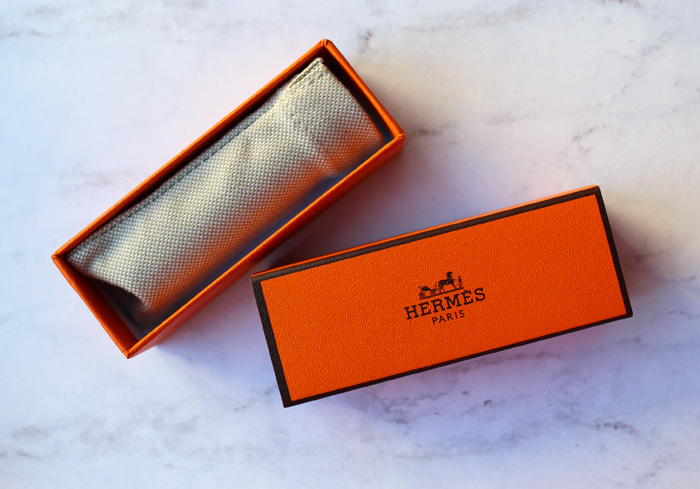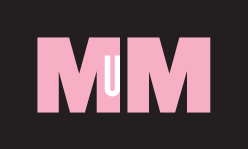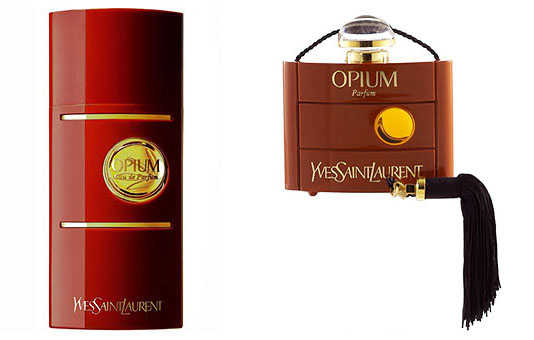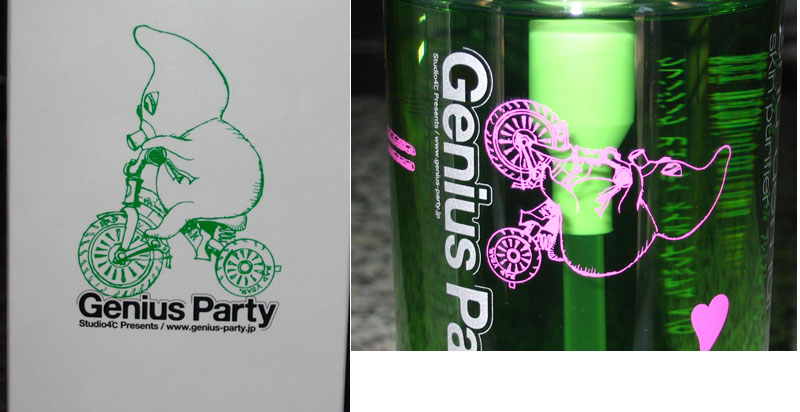1 "Designs Reveal Artist's Personality", Nadine Kam, January 11, 2007. https://starbulletin.com/2007/01/11/features/story02.html. To watch an interview with Legno, click here.
Here’s a bit of luxury to start off your week! (Yes, I backdated this post.) Hermès, historic French purveyor of fine leather goods and other accessories since 1837, debuted a lipstick line back in March. Once I saw the modern color-blocked tubes I knew some of them had to make their way into the Museum’s collection, so I picked up a few of the limited-edition ones and one from the permanent line. I’m not going to spend any time discussing the merits of the Birkin bag vs. the Kelly or anything else related to Hermès fashion and history, as there are any number of resources out there. Instead, I’ll talk about the house of Hermès in passing only as it relates to the lipstick.
I love the canvas pouch and signature orange box each are housed in. The tubes were created by Pierre Hardy, creative director of Hermès jewelry and shoes.
The caps are engraved with the ex-libris emblem chosen by Émile Maurice Hermès for his personal library in 1923. “The top curves inward a bit like a fingerprint, giving it a little softness…an anticipation of the gesture to come,” Hardy explains to Wallpaper magazine.
I adore the color combinations and the material is equally impressive. Though the tubes may resemble some sort of plastic, they are entirely free of it and are also refillable. The brushed metal on the tubes used for the permanent shades is a nod to Hermes’s “perma-brass” fixtures on their bags. I’ll let Wallpaper expand on the design: “Each lipstick tube is made of 15 different elements by partner workshops in France and Italy. Refillable, they are meant to be kept as precious objects, like jewels. The modern graphic design of the tubes contrasts with the classic ex-libris on the cap. The top half of the tube is white, or what Hardy calls ‘the image of purity and simplicity’. Hardy will play around more freely with the colour blocks of these tubes, finding ‘harmonies’ with each individual shade. For the first edition, an intense purple lipstick comes in a tube with bands of red and cornflower blue, while a coral shade is offset by emerald green. The overall effect is very Memphis Group…Prior to this, Hardy had no experience with beauty products, and neither, really, did Hermès. He says there were advantages in approaching the design with a blank slate. ‘I thought, let’s act as though nothing else existed. I will try to create the quintessence of an object that is feminine, pure, simple. One that is immediately desirable but will stand the test of time, and that can convey the Hermès style: luxury and sobriety.'”
A couple of points here: first, the very old idea of makeup containers as jewelry or art objects is obviously still going strong in 21st century. Second, I had to google the Memphis Group (they’re a design collective from the ’80s, FYI) but the resemblance in terms of color-blocking is striking.

(image from designmuseum.org)
Third, the article says that Hardy had not designed makeup before. This is not exactly true, as he collaborated with NARS on a collection back in 2013. Do you remember the adorable little shoe duster bags for the nail polish duos? I’m almost positive this charming design touch was Hardy’s idea.
In addition to makeup as jewelry, Hardy brings up another age-old idea: makeup as art, specifically painting. Regarding the lip pencil and brush he designed for Hermès in addition to the tubes, he remarks, “I studied visual arts, and these materials – brushes, pencils – resemble what we used back then. It is interesting to approach the question of femininity like a painter: what can we offer a woman so she can be an artist of her own beauty?”
Now let’s talk about the lipsticks themselves. Jérôme Touron, formerly of Dior and Chanel, was hired as the creative director of Rouge Hermès specifically to oversee the shade selection and textures. Each of the 24 colors (the number based on the house’s address at 24 Rue du Faubourg Saint Honoré) is inspired by the roughly 900 leather colors and over 75,000 silk swatches from the company’s archives. While it was difficult to narrow down the initial lineup, Touron enjoyed the “pure freedom” of digging through the archives. “It’s like a carré [square]; there is a profusion, an infinity of possibilities, and at the same time, a frame, that is clear and precise. Make-up works exactly the same way; there is an infinity of options in terms of colours, textures and types of application and at the same time it has to meet a certain function.” The matte Orange Boîte, shown below, is a direct reference to Hermès’s orange boxes, while Rouge H is from a color released in 1925 that I may have to buy. As Touron explains, “[Emile] introduced at the International Exhibition of Modern Decorative and Industrial Arts in Paris, with a truly pioneering spirit: he was the first to ask his tanners to create an exclusive ‘signature’ shade for leather. This colour immediately became a signature colour for Hermès because of its unique and singular hue: different (darker) from the Art Deco bright red of the time.”
 (images from hermes and therealreal.com)
(images from hermes and therealreal.com)
The lipsticks are allegedly scented with a custom fragrance concocted by the brand’s perfumer Christine Nagel with notes of sandalwood, arnica and angelica, but I couldn’t detect any scent. (Hopefully I’m not developing COVID.) There are 10 with matte finishes and 14 with satin, representing the various finishes of leathers, Doblis suede for the mattes and calfskin for the satins. However, Elle magazine reports that the satin texture is inspired by the company’s silk scarves, so who knows.
Hermès plans on releasing limited edition shades every 6 months, so I purchased the three fall 2020 colors. I really will try not to buy all three each and every season because it might not be the best use of the Museum’s budget, but the color-blocking is just so irresistible (even if we have seen it on lipstick before). And as a collector there’s a compulsion to have them all.
Also, all of the shades of the limited-edition lipsticks are inspired by an 1855 book Touron refers to when creating colors: The Principles of Harmony and Contrast of Colours and Their Applications to the Arts by Michel-Eugène Chevreul (that’s a mouthful!)
I’m still scratching my head over what exactly Touron does. I thought for sure he was a makeup artist since most lines have a makeup artist involved, but apparently he is a “product developer” according to the Wall Street Journal. The article reports that the decision not to hire a makeup artist or celebrity face was intentional. “‘The idea of one makeup artist giving all the rules was not ours,’ says [President and CEO of Hermès Parfums] Agnes de Villers. Touron is a product developer. He used makeup artists to help him test and develop products, but no one is signing a product group or telling anyone how to wear anything. For [artistic director Pierre Alexis] Dumas, that approach infantilizes customers. ‘We’ve always relied on the good sense and intelligence of our clients,’ he says. There will be no Hermès ‘face of the season’ or step-by-step inserts with line drawings. As Dumas puts it: ‘Lipstick is not a status symbol, nor a sign of submission to an order, but an affirmation of the self.'” It’s certainly a unique approach and only time will tell whether it pays off.
I have to say I wasn’t impressed with Touron’s reasoning for starting with a lipstick or its meaning. “I think the lipstick is special because it has the ability to reveal personality in a few seconds, in a single gesture, in just one application. Instantly, it reveals the colour of the personality. In a way, it exemplifies our conception of beauty: to reveal, not to transform. Hence the desire to start the Hermès Beauty with a lipstick collection. Also, perhaps because a lipstick concentrates in a very small size, our whole approach to the object, the colour, the material and the gesture in other words, some of the great fundamentals of Hermès.” Eh. I wish he had been honest rather than trying to spin it into something more profound than what it is: good business sense. Nearly all major cosmetic lines start with one product and it’s usually lipstick because it’s the most profitable makeup item and a good way to test the waters. Lipstick is really a barometer to see how the line is received and whether there’s interest in a full collection. As for the “gesture” nonsense it’s really just the brand’s tagline of “beauty is a gesture”, and I also think makeup can absolutely be transformative, even as it’s “revealing” one’s true colors. I did, however, enjoy the beautiful boxed set he came up with for the holiday season and his description of the relationship between color and music. The Piano Box set contains all 24 permanent shades. “Laid out in a line with their black and white lacquering, the lipsticks looked just like piano keys…for me, colors are like musical notes; they can be combined to create harmonies and resonance. More fundamentally, color, like music, is at the same time a precise system—like a frame, and something free, artistic, and deeply emotional.” That could explain why there are so many music-themed makeup objects!

(image from hermes.com)
Anyway, what’s especially interesting is that nearly every article claims this is the first time Hermès released lipstick. That is not true and I have the photos to prove it. A very kind Museum supporter on Instagram sent me images of a previous lipstick by Hermès. She’s not sure exactly when they came out, but according to newspaper articles it debuted in early 2001 in the U.S., selling for $25. The Wall Street Journal cited earlier reports that artistic director Pierre Alexis Dumas had suggested lipstick back in 2000 but that the company turned out not to be ready for a full line. “‘I think I was the one who suggested to my father [Jean-Louis Dumas, the late chairman and creative director of the house] that we should register the name for lipstick.’ They didn’t do it then—instead just once making a single shade of red lipstick in limited edition. They needed to think it through some more.” However, this photo shows a number on the lipstick which implies there were more shades. Perhaps in Europe, where this online friend of mine is based, offered more colors and in the U.S. we only got one.

(images from @amalia.vet)
In looking at the older lipstick and comparing it to the 2020 version, I must say the new line is far superior design-wise than Hermès’s previous attempt at makeup. It makes sense, since Touron, Hardy, Nagel, Dumas, along with Bali Barret, director of Hermès Women, spent 3 years bringing the cosmetics line to fruition. There wasn’t nearly as much fanfare or press for the earlier release, which leads me to believe it was more of a quick money grab led primarily by their marketing department without any real thought put into it – one can tell top executives and designers were not too hands-on. I’m all for minimal style, but the slim, plain packaging reads as very uninspired and not at all distinct from other brands, nor does it really capture Hermès’s vision. This could also be the reason why the line failed within a year – I saw no mention of it after March 2002 – and why nearly all the coverage for the new line omits any reference to their earlier foray into cosmetics. In hindsight, the company may see it as a mistake and prefer that it stays buried in newspaper archives…unfortunately for them, beauty aficionados don’t forget!
Anyway, as with other luxury makeup, many people will want to know whether Hermès lipstick is worth shelling out a significant amount of money for. On the surface, $67-$72 is an absurd price for a single lipstick. But as I noted with Louboutin nail polish, you’re not just paying for the product; you’re paying for the Hermès name along with all of the thoughtful details outlined above, not to mention that they are more affordable than nearly any other Hermès item (the leather cases for the lipsticks start at $340). Having said that, there are plenty of other quality lipsticks to choose from if you’re not into forking over some 70 bucks for the name or packaging. Most reviews have indicated that Hermès performs well although not necessarily better than other high-end brands, so splurging on one (or several) because of the luxurious feel makes sense. But I don’t believe any of the ingredients or technology in the product by itself warrant the price tag – beeswax, shea butter and mulberry extract are not that special, after all. Bottom line: if you’re wondering whether it’s worth it to buy these, yes, but only if you’re really into all the luxurious bells and whistles, a collector or if you love the brand. Again, if you just want a lipstick that performs well and don’t care about the label, pretty orange boxes and colorful tubes, there are many comparable lipsticks out there.
To conclude, I’m really enjoying Rouge Hermès despite the fact that I haven’t swatched any of the lipsticks I purchased (although it is very tempting!) You know I admire attention to detail when it comes to makeup packaging and design, and these tick every box. I also think these tie into the company’s aristocratic history but look much more approachable than I was expecting. I always perceived Hermès as a sort of blue-blood, old-money type brand – I mean, they started as a company that made fancy leather horse saddles and harnesses for people wealthy enough to consider equestrianism a hobby – but the modern and colorful design of the lipsticks proves they may not be as stuffy as I thought. Still, I’d like to see more adventurous shades and textures, i.e. their Malachite green or a glitter finish. And obviously they need more diversity in their advertising. I can’t say I’ve seen any, ahem, mature-looking models or anyone resembling a gender besides cis women, so hopefully they’ll branch out a bit while still keeping true to the brand’s heritage. A full makeup line is planned to be in place by 2023, so fingers crossed we’ll see some other interesting limited edition items…maybe a Birkin-embossed highlighter or one of their scarf patterns printed on the outer cases. 😉
What do you think of Rouge Hermès? Would you or have you tried them?





































